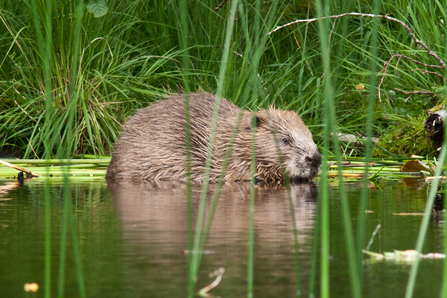A little over six months ago, we welcomed two unexpected new residents to our Helman Tor nature reserve. Although we weren’t expecting an unauthorised release by a still-unknown third party, combined with the recent publication of Beaver Vision, it's time to reflect on the impact the beavers have made and whether our plans need to change.
Six months of beavers at Helman Tor: what's changed?
Beaver kit swimming at The Cornwall Beaver Project, Image by Adrian Langdon

Adult beaver at Knapdale, Scottish Wildlife Trust (c)
When the beavers were discovered at Helman Tor earlier this year, we were well-placed to respond as we had been discussing the ambition of reintroducing beavers for several years. In preparation for the Government allowing wild releases, we had been developing a wild release licence application.
This meant that when the beavers were spotted we could understand their potential impacts on the local environment, mitigate any we didn’t want, and monitor the pair as they explored their new home.
Trail cameras have confirmed that we have a pair of beavers, who have now established a territory on our reserve. The beavers were particularly busy in July - as the water levels dropped, they got to work constructing their first dam.
We are continuing to put together our wild release application, which we hope will be one of the first applications in the country.
At our Helman Tor complex, the beavers grazing on leaves and woody material has lead to trees being coppiced and felled. This has resulted in a more complex and dynamic habitat being created.
The woody, leaky dam has started to change the environment, holding more water on site, and we have also seen other wildlife making the most of the return of this keystone species.
Our Beaver Officer Lauren, said: “We have been monitoring beaver activity across the reserve using camera traps. We have captured lots of wildlife interacting with the beaver-created habitat.
Heron are regularly using beaver-created pools, dragonflies are skimming the pools and small mammals using the dam to cross the river.
The leaky dam is holding back more water on our site and slowing the flow. This is a benefit to certain habitats on site, including wetland and wet woodland area, particularly during periods of hot weather and low flows”.

Heron using a beaver dam to rest and cross the river at Helman Tor
As you might expect with an animal so well-known for stopping water draining away, there’s a lot more of it near their dam than before!
Helman Tor Reserve Manager, Andy, said:
“It is really interesting to see what impact the beaver dam will have on the habitat here at Helman Tor. It is important that whilst the beavers are establishing their territory, we can allow the dam to stay.
However, our Reserves Team have their Beaver Management Licences, so if we do need to intervene with dam management techniques, we are ready!”

Adrian Langdon
So what happens next?
We will continue our wild release licence application, working closely with the local community and landowners to make sure the next eco engineers to call Cornwall home are released in the right way.
Autumn will see our Beaver Team host public consultation events across the Par and Fowey catchments, which will provide an opportunity for anyone interested to come and learn more about our proposed wild release, consider our Beaver Management Plan and provide feedback and thoughts.
Winter will see our team at Cornwall Wildlife Trust work closely with experienced partners, including the Beaver Trust, to health screen the pair of beavers currently at Helman Tor.
Finally, last Thursday (29th August), The Wildlife Trust released ‘A vision for the return of beavers to England and Wales’, setting out their ambition to bring back beavers to the wild. The Wildlife Trusts have 5 key asks from the UK and Welsh Governments:
-
Publish an ambitious beaver reintroduction strategy
-
Fund farmers and land managers in the two countries to make more space for water on their land
-
Support beaver management groups
-
Confirm all wild beavers can remain in England and Wales
-
Recognise beavers as a native species in Wales and provide them with full legal protection
Here at Cornwall Wildlife Trust, we support these keys asks, which will enable controlled, monitored wild releases where we can be confident it’s happened in the right way.




